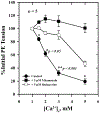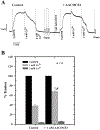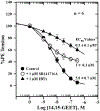Cytochrome P-450 metabolites of 2-arachidonoylglycerol play a role in Ca2+-induced relaxation of rat mesenteric arteries
- PMID: 18375719
- PMCID: PMC10433144
- DOI: 10.1152/ajpheart.01042.2007
Cytochrome P-450 metabolites of 2-arachidonoylglycerol play a role in Ca2+-induced relaxation of rat mesenteric arteries
Abstract
The perivascular sensory nerve (PvN) Ca(2+)-sensing receptor (CaR) is implicated in Ca(2+)-induced relaxation of isolated, phenylephrine (PE)-contracted mesenteric arteries, which involves the vascular endogenous cannabinoid system. We determined the effect of inhibition of diacylglycerol (DAG) lipase (DAGL), phospholipase A(2) (PLA(2)), and cytochrome P-450 (CYP) on Ca(2+)-induced relaxation of PE-contracted rat mesenteric arteries. Our findings indicate that Ca(2+)-induced vasorelaxation is not dependent on the endothelium. The DAGL inhibitor RHC 802675 (1 microM) and the CYP and PLA(2) inhibitors quinacrine (5 microM) (EC(50): RHC 802675 2.8 +/- 0.4 mM vs. control 1.4 +/- 0.3 mM; quinacrine 4.8 +/- 0.4 mM vs. control 2.0 +/- 0.3 mM; n = 5) and arachidonyltrifluoromethyl ketone (AACOCF(3), 1 microM) reduced Ca(2+)-induced relaxation of mesenteric arteries. Synthetic 2-arachidonoylglycerol (2-AG) and glycerated epoxyeicosatrienoic acids (GEETs) induced concentration-dependent relaxation of isolated arteries. 2-AG relaxations were blocked by iberiotoxin (IBTX) (EC(50): control 0.96 +/- 0.14 nM, IBTX 1.3 +/- 0.5 microM) and miconazole (48 +/- 3%), and 11,12-GEET responses were blocked by IBTX (EC(50): control 55 +/- 9 nM, IBTX 690 +/- 96 nM) and SR-141716A. The data suggest that activation of the CaR in the PvN network by Ca(2+) leads to synthesis and/or release of metabolites of the CYP epoxygenase pathway and metabolism of DAG to 2-AG and subsequently to GEETs. The findings indicate a role for 2-AG and its metabolites in Ca(2+)-induced relaxation of resistance arteries; therefore this receptor may be a potential target for the development of new vasodilator compounds for antihypertensive therapy.
Figures









References
-
- Akita S, Sacks FM, Svetkey LP, Conlin PR, Kimura G. Effects of the Dietary Approaches to Stop Hypertension (DASH) diet on the pressurenatriuresis relationship. Hypertension 42: 8–13, 2003. - PubMed
-
- Angus JA, Wright CE. Techniques to study the pharmacodynamics of isolated large and small blood vessels. J Pharmacol Toxicol Methods 44: 395–407, 2000. - PubMed
-
- Appel LJ, Moore TJ, Obarzanek E, Vollmer WM, Svetkey LP, Sacks FM, Bray GA, Vogt TM, Cutler JA, Windhauser MM, Lin PH, Karanja N. A clinical trial of the effects of dietary patterns on blood pressure. DASH Collaborative Research Group. N Engl J Med 336: 1117–1124, 1997. - PubMed
-
- Appel LJ, Brands MW, Daniels SR, Karanja N, Elmer PJ, Sacks FM. Dietary approaches to prevent and treat hypertension. A scientific statement from the American Heart Association. Hypertension 47: 296–308, 2006. - PubMed
-
- Archer SL, Gragasin FS, Wu X, Wang S, McMurtry S, Kim DH, Platonov M, Koshal A, Hashimoto K, Campbell WB, Falck JR, Michelakis ED. Endothelium-derived hyperpolarizing factor in human internal mammary artery is 11,12-epoxyeicosatrienoic acid and causes relaxation by activating smooth muscle BKCa channels. Circulation 107: 769–776, 2003. - PubMed
Publication types
MeSH terms
Substances
Grants and funding
LinkOut - more resources
Full Text Sources
Research Materials
Miscellaneous

